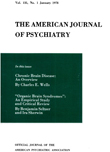THE EFFECT OF VARIOUS MEDICATIONS ON PATIENTS MANIFESTING AN EPILEPTIFORM SYNDROME
Abstract
One hundred and thirty cases presenting a syndrome including cranialgia, emotional instability, vasomotor instability, impaired consciousness, loss of consciousness, personality disorders and epilepsy, have been found to have a common EEG component, namely half and double alpha variants. Ninety-five percent of the cases had impaired states of consciousness and a significant proportion grand mal epileptic features. The series has shown a selective response to trials on several medications, improvement occurring in 90% of patients placed on dilantin sodium. Phenobarbital or sodium amytal were of little benefit. It is suggested this syndrome is more inclusive than those conditions variously described as psychomotor attacks, psychic variants or equivalents, or psychical seizures, and warrants the term epileptiform syndrome. The syndrome enlarges our conception of the limits of epilepsy.
Access content
To read the fulltext, please use one of the options below to sign in or purchase access.- Personal login
- Institutional Login
- Sign in via OpenAthens
- Register for access
-
Please login/register if you wish to pair your device and check access availability.
Not a subscriber?
PsychiatryOnline subscription options offer access to the DSM-5 library, books, journals, CME, and patient resources. This all-in-one virtual library provides psychiatrists and mental health professionals with key resources for diagnosis, treatment, research, and professional development.
Need more help? PsychiatryOnline Customer Service may be reached by emailing [email protected] or by calling 800-368-5777 (in the U.S.) or 703-907-7322 (outside the U.S.).



